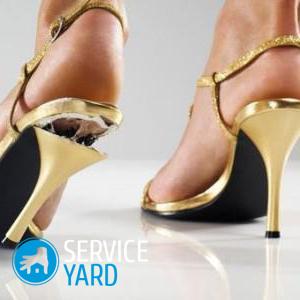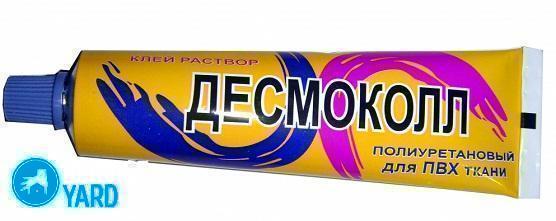Which glue is better for shoes?

We all once came to bitter disappointment when at some point we paid attention to our favorite shoes, which begin to fall apart before our eyes. Under the influence of external factors: snow, rain, mud, frost, and the general adverse effect, including mechanical damage, we are shocked - what should we do, because we have not planned to buy a new pair yet. From this article you will learn which glue is best for shoes and how to seal shoes at home.
to contents ↑How to choose glue?
Before making a choice in the direction of this or that glue, you should consider what material the shoes are made of and how difficult the damage is. Here you need to consider:
- Where did the gap form and what materials (leather, fabric, suederubber) will have to glue. Each of these materials has its own molecular structure and a different reaction occurs under the influence of chemical materials.
- The durability of the connection. If you only need to inform the couple this season, you can buy a less reliable, but easy to use and cheap solution. To seal the crack for sure, it is better to give preference to the glue that will hold the material in an unchanged state for at least another year or two.
- Resistance to moisture. Each glue has its own moisture resistance threshold. For bonding soles or repairing winter, autumn shoes, it is better to give preference to a solution that has a higher threshold of similar resistance, because rain water and snow will constantly affect the shoes.
- UV resistant. This factor must be taken into account if you will wear a repaired pair in the summer.
- Elasticity, so that glued seams do not crack. If you glue the shoes with the first compound that comes to hand, which, after polymerization, gains high hardness, after a couple of days you will again look for the answer to the question of which glue for shoes is better and how to glue the shoes at home.
- Price quality. All adhesives differ in their component composition, but in one line of a particular group of solutions you can find products from different manufacturers. They will differ in price and quality of fixation. Buy one that does not hit your budget lightly, but provides the desired level of reliability.
to contents ↑Important! Depending on the degree of damage, the amount of work and the properties of the material, you need to understand on the basis of what you need to choose glue. That is, with what glue it is better and more reliable to glue the sole or upper small parts of the shoe.
The best glue for the sole
If you appreciated the degree of damage and decided to glue the shoes at home, now you will be faced with a choice, which glue is better for shoes? Truly in the age of modern technology, all means are good for a specific purpose. And in our case, glue based on polyurethane is suitable for gluing the soles of shoes.
Important! Polyurethanes are a group of synthetic elastomers that are incredibly widely used in light industry. The range of performance characteristics of just such solutions is very wide, which allows the use of polyurethane as a rubber substitute in the manufacture of various products operating in aggressive environments, under heavy loads and temperatures. The operating temperature range is from −50 C to +70 C.
Now we will consider some good brands of glue and their properties.Based on this information, you can decide which glue is best for shoes in your case. There are many such compositions; Desmokol is one of the most popular in work with shoes.
Clay "Desmokol"
Glue "Desmokol" (polyurethane) - a widely used solution in the shoe industry. It is characterized by excellent moisture resistance and a durable adhesive joint without color and with a good degree of transparency.
The main purpose of this glue is the shoe industry, and it is used both in the manufacture and repair of shoes:
- “Desmokol” allows you to quickly and reliably glue the upper of shoes made of dense textile, leather to the sole of polyurethane, rubber, thermoplastic elastomers.
- They grease the workpieces and glue the soles.

Such polyurethane adhesive is characterized by good strength fasteners, due to the fact that it hardens strongly after application. It also increases significantly in volume, therefore, it makes it possible to reliably fasten even porous surfaces.
Universal glue “MOMENT”
The name “universal” itself indicates that the adhesive has a wide range of glued surfaces - from rubber, leather, fabric to wood, ceramics, plastic, glass.
“Moment” is a transparent contact adhesive that transparently glues soft and hard materials.
to contents ↑Important! This glue allows to achieve transparency of the adhesive joint, high bonding strength. Very high frost and heat resistance in combination with resistance to the influence of dilute acids and alkalis makes this adhesive truly universal.
The best glue for upper shoes
To glue more delicate parts of shoes, an adhesive with a high drying coefficient and a minimum expansion property is required.
Glue “Nairit”
If your shoe has damage to the upper part of the shoe, where you have to work more with natural, synthetic leather and fabric, then in your case the Nairit universal contact polychloroprene adhesive is suitable.
“Nairit” is intended for gluing the top of shoes made of genuine and synthetic leather to the sole materials of rubber (almost all types), leather. Also glue is used for:
- bonding tight;
- pasting insoles;
- lining, reinforcing and elastic elements.
Important! This solution is very good at gluing those places that will be exposed to moisture. The main disadvantage is that it is not good enough for bonding the top of the shoe with a sole made of polyurethane.
Combined adhesive “Eva”
Good glue for the first coating of the edge of the workpiece, joining the top and repairing rubber soles, for construction and adhesive fasteners. It is perfect when you need to attach a synthetic or leather upper to the sole. The combined mixture is made from polymeric substances such as rubber, nairite, various resins.
to contents ↑Important! It is also used when it is necessary to lubricate welts and seal the seams.
How to glue the sole of the shoe:
Tips for using shoe glue are simple and well-known. If you do not know exactly how to glue the shoes at home, since you have not yet had to do this, consider these recommendations:
- To prepare, clean the glued surfaces from dirt.
- Previously, the shoes must be dry, otherwise the glue in combination with moisture will not fulfill its purpose.
- Using a solvent, alcohol or homemade cologne, degrease the sides of the material that we will be joining.
- Rubber should be halogenated, parts made of polyurethane should be degreased or tousled, and polyvinyl chloride should always be degreased.
- The number of application layers varies in each case. Here you need to consider what kind of joint strength you plan to receive and information from the manufacturer. As a rule, any glue for shoes is applied in 1-2 layers.
- Prepare the clamps.
- Join the glued surfaces and press firmly.
- Place under a press or tightly fix with clips.
- Drying time to full fixation is usually 24 hours. But read the instructions from the manufacturer of the adhesive, which indicates the exact working time of the solution and setting time.
to contents ↑Important! An important fact will be what kind of clamping force you give to the glued surfaces. In the first minutes of compression, the stronger you press, the stronger and more reliable the joints on your shoes will hold.
Stock footage
We hope that from this review you got the answer to your question, which glue is better for shoes and how to glue shoes at home. Next - try to purchase shoes only from a reliable manufacturer and properly care for them so that they do not burst at the seams and do not fall apart in the sole.
- How to choose a vacuum cleaner taking into account the characteristics of the house and coatings?
- What to look for when choosing a water delivery
- How to quickly create comfort at home - tips for housewives
- How to choose the perfect TV - useful tips
- What to look for when choosing blinds
- What should be running shoes?
- What useful things can you buy in a hardware store
- Iphone 11 pro max review
- Than iPhone is better than Android smartphones



